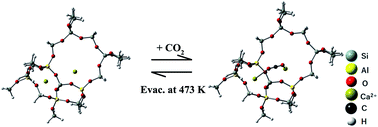Science Daily May 6, 2021
Researchers in Japan designed an ion-exchanging method using an A-type zeolite (silicon/aluminum ratio of 1) because of its appropriate pore size for adsorbing CO2. The alkaline-earth ion exchange imparted a large electric field strength that, supposedly, acted as a driving force for the adsorption. They chose a doubly charged calcium ion as the exchange ion since it allowed for the greatest amount of adsorption. To investigate the underlying adsorption mechanism, they carried out far-IR measurements and backed them up with density functional theory calculations. It showed a distinct shift towards longer wavelengths following CO2 adsorption. They were able to completely desorb the adsorbed CO2 and recover the original sample and its specific adsorption properties. The sample showed a superior selective adsorption of CO2 from other gases. The work opens doors to potentially novel applications of zeolites, such as in the cleaning of air inside semi-closed spaces including space shuttles, submarines, and concert halls, and as an adsorbent material in the anesthetic process…read more. TECHNICAL ARTICLE

Abstract. Credit: Journal of Materials Chemistry, Issue 12, 2021